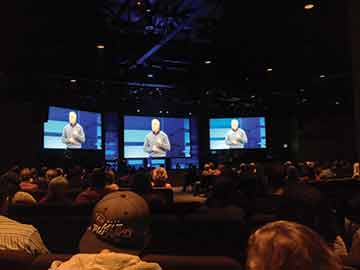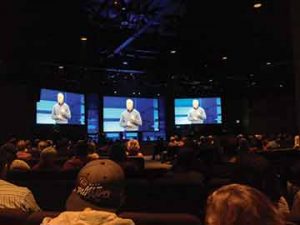
By Jim Tomberlin
How to reproduce ministry best practices — consistently — across multiple locations
When I came to my church in Colorado in 1991, the cutting-edge technology was an overhead projector. Today, we’re delivering messages — and messengers — on video screens.
The technological developments of the last two decades laid the foundation for the multisite church movement. The ability to capture gifted teachers and preachers on high-quality video, and deliver it to other locations, makes church accessible in a way never imagined before.
Today, every week, more than 5 million people attend one of the 8,000-plus multisite churches across North America. Truly multisite has become the “new normal” for healthy, growing, outreach-oriented churches.
The key to success in a multisite church is the ability to reproduce ministry best practices consistently across multiple locations. One of the first questions to address in going multisite is, How will we deliver our sermon content? The question usually revolves around the issue of live, in-person teaching versus video-delivered sermons.
According to the latest survey from Leadership Network, only half of multisite churches use video to deliver their sermons to multiple locations. The same survey also revealed that the larger the church attendance, and the more campuses it has, the more inclined that church was to use video delivery.

Delivery methods, explained
The easiest and least expensive way to deliver video sermons is to capture the sermon on a DVD or hard drive and deliver it to the multisite campuses the next day or the following Sunday. This is how the majority of video-based multisite churches deliver their sermon content.
A small (but growing) number of churches use satellite technology to deliver their messages across multiple locations. The initial cost of using satellite technology is expensive, but it’s the most cost-effective for churches with more than three campuses, or with campuses spread over long distances.
The third way to deliver sermon content is to video-stream it over the internet. This allows real-time or delayed delivery. Even though this is often the most expensive option and has internet reliability issues, it’s growing in popularity and will most likely become the primary way churches will deliver video content in the years ahead as the cost goes down and internet reliability improves.
Churches that use video sermons typically use high-definition cameras for a “full body” camera angle and project on a large, center screen at the receiving campus. Many churches also add smaller side screens for a close-up head shot of the speaker and use the lower third of the screen to scroll biblical references or sermon notes.
The primary concern churches have about video sermons is whether or not their people will accept them. Most church people express reluctance to embrace video sermons, but quickly do when sermons of gifted communicators are captured and presented well.

Here’s what I’ve observed about video sermons: Bad preaching on video doesn’t work. Good preaching — captured and presented poorly — doesn’t work. But, when captured and presented decently, good preaching works everywhere, whether in suburban, urban or rural communities.
Video sermons leverage the teaching gifts of dynamic communicators and ensure that local churches can deliver their messages consistently to all their locations.
Not everyone is going to like video sermons. Not everyone has to — just enough need to. And, unchurched people are far less uptight about the medium than church people. They’re more concerned if the person on the screen has something meaningful to say in an engaging way.
The Apostle Paul declared in the first century that he was willing to do new things to reach more people. Evangelist Billy Graham demonstrated in the last century how technology can be used to reach more people. Today, multisite churches are following the example of the Apostle Paul and evangelist Billy Graham in taking church to the people. Video sermons work because it’s not about the medium; it’s about the message.
Jim Tomberlin is founder and senior strategist of MultiSite Solutions, a company dedicated to assisting churches in extending their impact through multiple locations. Over three decades of diverse ministry, Tomberlin has pastored a church in Germany, grown a megachurch in Colorado, and pioneered the multisite strategy for Willow Creek Community Church in Chicago.



Why multisite? For the same reason we plant churches–to make more disciples of Jesus.
I am truly mystified by this “multi-site church trend.” Whatever happened to planting new churches, nurturing them as they grew and then letting them stand on their own? Why do we need “church franchises?”